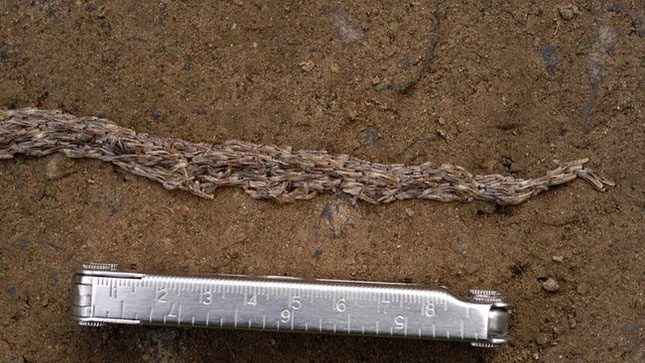Researchers have decoded the mystery of the “snake worm” in Alaska after discovering a new species of fungus gnat larvae that gather together and slither around like a long gray snake.
The mystery of this snake-like worm began over 16 years ago, in the summer of 2007, when Maggie Billington, a resident of Ester, spotted thousands of tiny worm-like larvae crawling along the road in long lines.
At the time, Billington was a volunteer at the University of Alaska’s Museum of the North in Fairbanks, so she documented the unusual sight and brought her photographs and samples to Derek Sikes, the museum’s entomologist.

Snake worm larvae crossing the road in Fairbanks, Alaska. (Photo: Derek Sikes).
Sikes stated: “I thought they must be fly larvae, but I had never heard of this snake worm phenomenon. To me, it was completely a mystery.”
The Mysterious “Snake Worm”
Sikes and his colleagues have now identified these larvae in a new study published on December 30 in the journal Systematic Entomology. They named the species Sciara serpens, which is one of the few studied species of flies in which the larvae resemble snakes.
The researchers speculate that the snake-like shape of these larvae helps to deter birds and other predators or to retain moisture on dry ground by crawling over one another in a line.
This new species belongs to the Sciaridae family, commonly known as fungus gnats. Many fly species are difficult to distinguish in their larval stages, so Sikes cared for the larvae collected from the second sighting of the snake worm in 2007 until they transformed into black-winged flies.
It wasn’t until 2021 that the research team confirmed this gnat is a new species to science. Lead author Thalles Pereira, an insect researcher at the Museum of the North, University of Alaska, examined the male gnat under a powerful microscope and found significant differences in shape compared to its European relatives.
Although it may seem strange that the Alaskan gnat shares more similarities with its European relatives than with other North American species, the researchers note that this follows a pattern observed in other insect species in Alaska, such as grasshoppers and beetles from the Pleistocene Epoch (2.6 million to 11,700 years ago). During that time, Alaska was connected to Europe and Asia via the Bering Land Bridge, allowing insects to disperse from eastern Siberia to Alaska while massive glaciers blocked the rest of North America.
- The Temple of Heaven in Beijing has a “mysterious” door, with three characters written by Emperor Qianlong, through which only one person passed in a hundred years.
- A close-up look at 5 new national treasures of the Thang Long Imperial Citadel and Co Loa.
- What happens when a tiger fights a wild boar and a crocodile suddenly appears?


















































